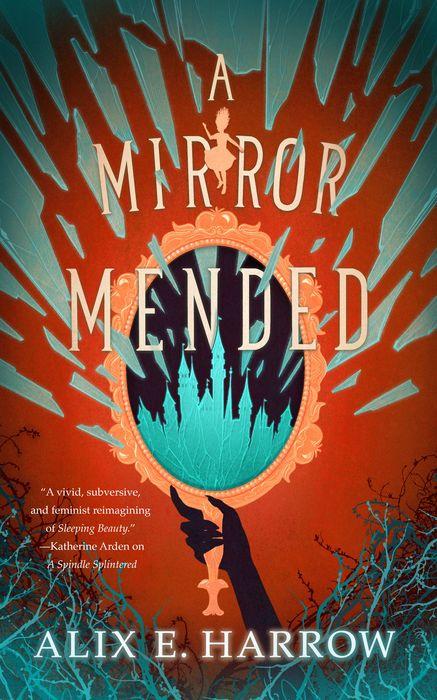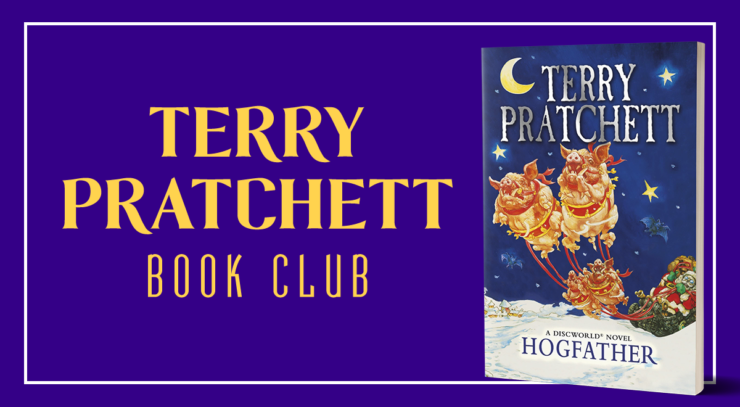Something something obligatory “Christmas in July” joke… it’s Hogfather time!
Summary
Ridcully has found a door that says it should never be opened, but wants it opened because there’s supposed to be a bathroom on the other side and he wants it for his own. Susan is working as a governess who kills monsters for the children she takes care of with a fireplace poker—she’s concerned that she’s begun to remember the future again, after having avoided it for two whole years. An Auditor of Reality comes to Lord Downey, head of the Assassin’s Guild, and commissions their services. They want the Hogfather killed, which should be impossible as he’s not quite real as far as Downey understands it. He calls in Mr. Teatime, who is unnerving even by assassin standards. It turns out that Teatime has already considered ways to kill the Hogfather (as well as a number of other mythical figures, and also Death), so he is pleased to take on the assignment. One of the children Susan takes care of worries that there might not be a Hogfather because a kid of the playground said it was just your dad doing it. Susan assures her that there is.
Mr. Teatime assembles a group of criminals to help him enact his plan. They assemble their crew and hitch a ride from a carter named Ernie, advising him to forget everything he sees and hears. Teatime gets Ernie to show them his snuffbox that contains a magical substance and opens a portal to another place, murders him, and takes the reins of his cart. Death comes to collect Ernie, looking about the Auditors; he’s sensed that there’s something off about what’s happening. The Death of Rats collects the latest mouse when the Hogfather appears… or rather Death appears dressed as the Hogfather. The Death of Rats follows Death onto the roof and hears him talking to someone obscured behind the sacks in his sleigh (it’s Albert, of course), saying that he’s worried because the notes left by children indicate that they don’t really believe anymore. The Death of Rats watches Death go, then has a conversation with a raven about what he just saw and hitches a ride.
Buy the Book


A Mirror Mended
Susan is drinking at Biers trying to have a night to herself when the Death of Rats and the raven show up and tell her what they’ve seen. Susan insists that she doesn’t have a grandfather and that they have to go, accidentally knocking the Death of Rats into an ashtray. They leave and Susan tries to pretend nothing has happened. Albert tries to give Death advice on how to better embody the role of the Hogfather so that it’s convincing. Albert doesn’t think this is any of Death’s business, but he also knows that if he doesn’t do this job right now, no one will. Susan goes back to the Gaiter’s home and boots out a bogeyman who harassed her earlier as Biers. The raven shows up and she tells him to leave her alone, then the Death of Rats tries to hide at the fairy at the top of the tree. He and the raven are there to warn Susan and she can feel time suddenly, the way she did before. Teatime and his crew are infiltrating a place and killing guards as they go.
Death shows up dressed as the Hogfather, and then Albert, and Susan tells them both off for this until Death explains that the Hogfather won’t be appearing this Hogswatch because he’s… dead. (Albert is not dying because they’re in the space allotted to the Hogfather when he delivers gifts, a space without time.) Susan demands to know why they are doing this, but Death insists that he cannot tell her and apologizes for intruding on her time. After they leave, Albert notes that Death insisting on Susan staying out of this almost guaranteed that she’d go poking her nose in, which was certainly not Death’s intention at all. Susan is angry, but she has to know why this is happening, and she stops Time. She calls for Binky and knows that if she takes this step, her life will stop being normal again—but she also knows that this is what she wants. She climbs onto Binky and goes.
Commentary
We’ve arrived at what I’ll call a halfway point in the Discworld series, given the body of work, and we’ve finally hit… perhaps not the most famous tome, but certainly among the ones that get quoted the most often.
From a craft standpoint, it’s not difficult to understand why the book is so beloved—the setup is basically flawless, starting with the rumination over beginnings and how we decide where they land and then how they frame our understanding of things. There’s also the introduction of Teatime, who perfectly straddles that line between interesting and horrifying, the sort of villain who unnerves you because he’s too cold to reach. (The opening bit where it’s suggested that the guild took him in because he lost both his parents, and that maybe should have been their first red flag, is, you know, the stuff actual horror movies are made of.) And combining that coldness with a smile always leaves an impression in the mind.
We’re back with Susan, who we learn has spent the last two years trying to forget everything about her that’s a little more than human. It makes sense, but it’s also heartbreaking; Susan is such a good character in the pantheon of “people who are too smart for their own good.” And I love the distinction that’s made between being educated and having instincts and intelligence, leaving us with this gem:
Getting an education was a bit like a communicable sexual disease. It made you unsuitable for a lot of jobs and then you had the urge to pass it on.
That sound you hear is generations crushed under student loan debt, crying out for vengeance and in desperate hope that others will also get that education despite their financial errors.
But what really stands out as you begin this story is the preoccupation with one of my favorite Pratchett-ian modes of thought: The question of what is real, and the understanding that reality is made up of beliefs. It’s relevant that Death is the one involved in a story about the Discworld version of Santa because he’s literally the only character who could be in this context. This is a story about the nature of being and existing with any sort of consciousness, and that’s precisely where the character lives. He’s the being who must shuttle us to and from our modes of reality via our beliefs.
Death is an anthropomorphic conception on the Disc, but I’ve also said before that I’d argue he’s the closest that Sir Terry comes to giving us his version of a deity. (The Discworld gods are enjoyable characters in their own right, but you never get the impression that Pratchett favors any of their religions or philosophies.) There’s a closeness to Death, his perspective and thoughts, and this book really cinches the idea in my mind. He’s the only appropriate character for a story like this, one that tackles how the human mind perceives the fantastical in order to shape what’s real.
Now, there’s a different awkwardness to this, which comes from the fact that Christians (even non-practicing people who come from Christian backgrounds) have a tendency to view Christmas and the figures involved as secular. That’s part of the scam, as it were—Christianity is a religion that profligates through conversion, and Christmas tries to make folks think it’s not a part to that conversation by often insisting that it’s barely religious at all. This is particularly true of the aspects of Christmas that are being pulled for this story, i.e. Santa Claus, flying reindeer, giving children presents, sending cards and putting up trees, and so on. But the fact of the matter is that these items are not neutral or secular, they’re still fully Christian concepts. (And yes, that’s still true even if people want to argue that elements of Christmas came from pagan holidays because we just talked about conversion, didn’t we? They’ve been usurped in these contexts.) So I’ll probably be talking a little bit more about how they’re used later on.
The section ends with Susan’s call to adventure, as it were, and I love her for fighting it, but I love her more for knowing that she can’t leave well enough alone. Reluctant heroes are so often the best kind because they remind us that having a measured reaction to something doesn’t mean that we’re standing still and doing nothing. Some of us just need a moment to get there.
Asides and little thoughts:
- I think it’s relevant that the longer these books go on, the more the ‘answers’ we’re supposed to glean become narrative asides from Didactylos saying “Things just happen. What the hell.” I mean… he’s right, and I find this about as philosophically comforting as anything.
- “Look at that, willya?” said the raven rhetorically. is something that I wish that raven had said to Edgar Allan Poe.
- The whole “yes, Twyla, there is a Hogfather” bit is obviously a riff on “yes, Virginia, there is a Santa Claus.” But the thing that snagged me on this read was realizing that the phrase has become so ubiquitous that most people probably don’t actually know where it comes from anymore. (In case you didn’t, it’s from an editorial in The Sun from 1897.)
Pratchettisms:
Everything starts somewhere, although many physicists disagree.
It separated those curs who went around murdering people for money from the gentlemen who were occasionally consulted by other gentlemen who wished to have removed, for a consideration, any inconvenient razor blades from the candyfloss of life.
“If I catch you being twee again I will knot your arms behind your head,” said Susan levelly.
After all, what was the point of teaching children to be children? They were naturally good at it.
To be a personality was to be a creature with a beginning and an end.
And, with ineffable smugness, they faded into the foreground.
The Death of Rats nibbled a bit of the pork pie because when you are the personification of the death of small rodents you have to behave in certain ways. He also piddled on one of the turnips for the same reason, although only metaphorically, because when you are a small skeleton in a black robe there are also some things you technically cannot do.
Gawain and Twyla, who’d been named by people who apparently loved them, had been put to bed by the time Susan got in, at their own insistence.
Rage overtook Susan’s curiosity. It had to travel quite fast.
And Susan was bright enough to know that the phrase “Someone ought to do something” was not, by itself, a helpful one. People who used it never added the rider “and that someone is me.”
Next week we read up to:
“I wish I knew who’s making that bloody tinkling noise,” said the Archchancellor.










